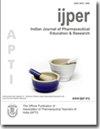荆草根茎水提物在链脲佐菌素诱导的糖尿病斑马鱼模型中抗糖尿病作用的评价
IF 0.8
4区 医学
Q3 EDUCATION, SCIENTIFIC DISCIPLINES
Indian Journal of Pharmaceutical Education and Research
Pub Date : 2023-10-04
DOI:10.5530/ijper.57.4.129
引用次数: 0
摘要
摘要:背景资料:糖尿病(DM)在新兴国家和发达国家均呈急剧上升趋势,近年来利用营养方法控制糖尿病引起了人们的广泛关注。香蕉(芭蕉属)是世界热带地区普遍受欢迎的植物。野生植物Musa acuminata,也被称为卡文迪什香蕉,生长在热带和亚热带气候中。近年来,尖锐毛霉的健康优势引起了人们的广泛关注。这种植物的每一种成分都被用于传统医学中治疗许多疾病。虽然已报道了沙草不同部位的抗糖尿病潜能,但尚未对其进行广泛研究。目的:考虑到目前关于棘豆抗糖尿病潜能的研究资料不足,我们提出利用斑马鱼模型对棘豆抗糖尿病潜能进行评估。材料与方法:采用链脲佐菌素(STZ)腹腔注射诱导斑马鱼糖尿病。将鱼置于2%蔗糖溶液中48小时诱导糖尿病,然后将鱼转移到分别含有10、20或30µg/mL玉米提取物的处理池中;第8天全部安乐死,进行生化和组织病理学分析。结果:10、20、30µg/mL的Musa acuminata Corm Extract (MACE)对糖尿病斑马鱼模型有显著的降血糖作用。从酶分析中可以明显看出这一点。组织病理学分析还显示,MACE处理组肠绒毛生长增强,杯状细胞数量增加。结论:MACE在预防高胆固醇血症和高脂血症等糖尿病并发症中的作用支持了其可作为辅助或替代其他糖尿病药物的说法。本研究确定的MACE抗糖尿病潜能的确切作用模式目前还不能完全破译。需要进一步的研究来缩小对这种作用负责的活性植物成分以及它发挥这种作用的机制。关键词:糖尿病,沙草提取物,抗糖尿病,斑马鱼本文章由计算机程序翻译,如有差异,请以英文原文为准。
Evaluation of the Aqueous Extract of Musa acuminata Corm (Rhizome) for its Anti-diabetic Potential in Streptozotocin (STZ) Induced Diabetic Zebrafish (Danio rerio) Model
Abstract: Background Information: Diabetes Mellitus (DM) is spiking substantially in both emerging and developed countries and the use of a nutritional approach to diabetes control has recently attracted a lot of attention. The banana (Musa spp.) is ubiquitously favourite in the tropical areas of the world. The wild plant species Musa acuminata, also referred to as the Cavendish banana, is found in tropical and subtropical climates. The health advantages of M. acuminata have drawn a lot of attention in recent years. Every component of the plant has been used in traditional medicine to treat numerous diseases. While the anti-diabetic potential of various parts of Musa acuminata has been reported, the corm has not been extensively studied. Objectives: Considering the lack of data on the anti-diabetic potential of M. acuminata corm, we proposed to evaluate the same using a zebra fish model. Materials and Methods: Diabetes was induced in zebrafish by intraperitoneal administration of Streptozotocin (STZ). The fishes were maintained in 2% sucrose solution for 48 hr for induction of diabetes after which they were transferred to the respective treatment tanks containing the corm extract at 10, 20 or 30 µg/mL; on Day 8, they were all euthanized and used for biochemical and histopathological analysis. Results: Musa acuminata Corm Extract (MACE), at 10, 20 and 30 µg/mL caused significant glucose lowering action in diabetic zebra fish model. This is evident from the enzyme analysis. The histopathological analysis also revealed the enhanced growth of villi and increased number of goblet cells in the intestine of MACE treated group. Conclusion: The role of MACE in preventing diabetic complications like hypercholesteremia and hyperlipidaemia supports its claim that it can be used as an adjuvant or as an alternative to other diabetic medications. The precise mode of action of the antidiabetic potential of MACE identified in this study could not be completely deciphered at this point. Additional research is required to narrow down on the active phytoconstituents responsible for this effect and also the mechanism by which it exerts this effect. Keywords: Diabetes mellitus, Musa acuminata Corm Extract (MACE), Anti-diabetic, Zebra fish
求助全文
通过发布文献求助,成功后即可免费获取论文全文。
去求助
来源期刊
CiteScore
1.40
自引率
0.00%
发文量
227
审稿时长
>12 weeks
期刊介绍:
The official journal of Association of Pharmaceutical Teachers of India (APTI) and is being published since 1967. IJPER, a quarterly publication devoted to publish reviews and research articles in pharmacy and the related disciplines of Pharmaceutical education. It mainly covers the articles of special interest, covering the areas of Pharmaceutical research, teaching and learning, laboratory innovations, education technology, curriculum design, examination reforms, training and other related issues. It encourages debates and discussions on the issues of vital importance to Pharmaceutical education and research. The goal of the journal is to provide the quality publications and publish most important research and review articles in the field of drug development and pharmaceutical education. It is circulated and referred by more than 6000 teachers, 40,000 students and over 1000 professionals working in Pharmaceutical industries, Regulatory departments, hospitals etc.

 求助内容:
求助内容: 应助结果提醒方式:
应助结果提醒方式:


